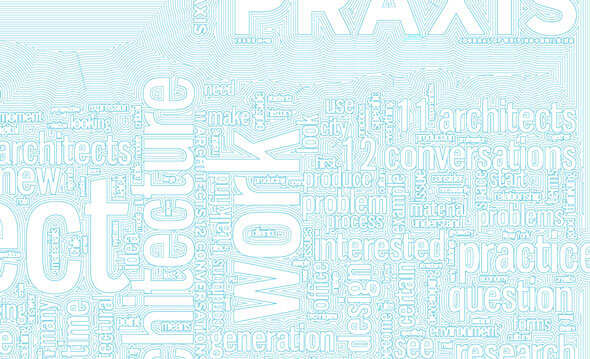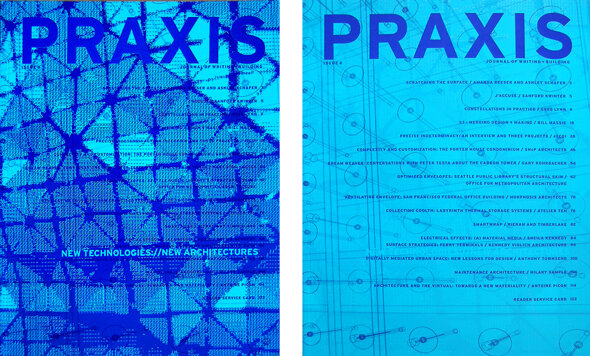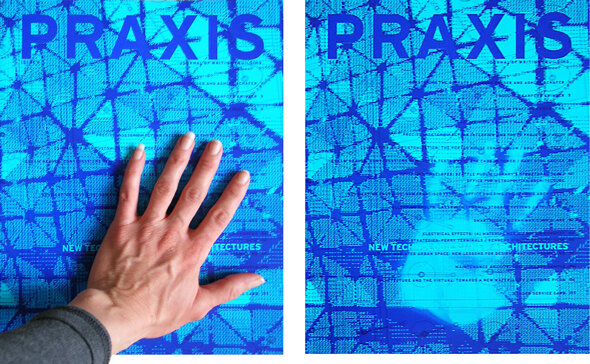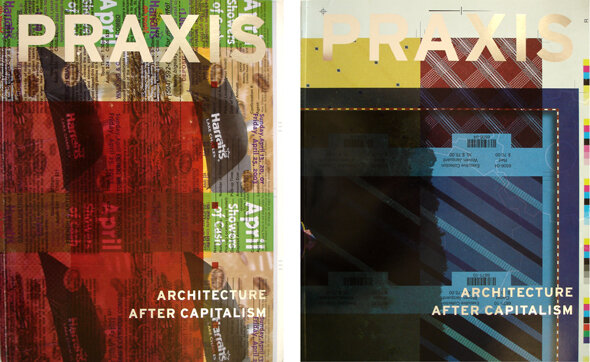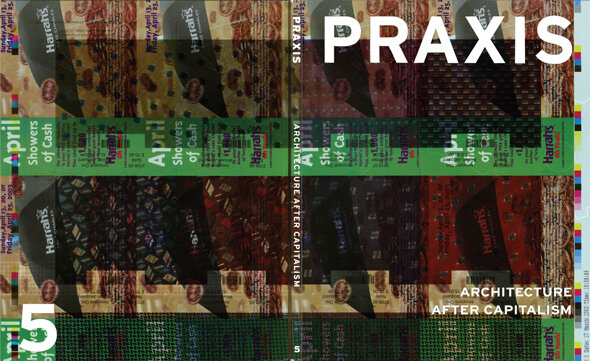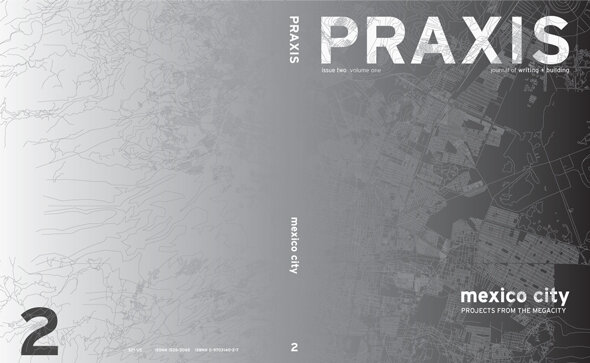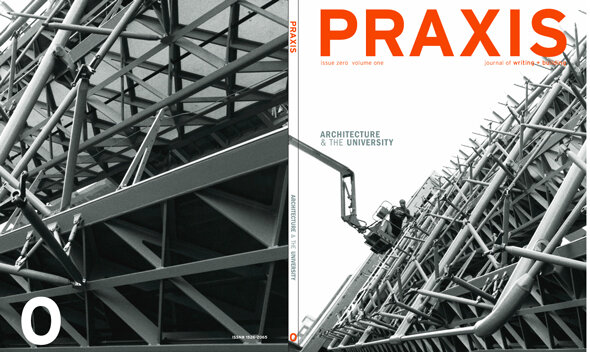Praxis
PRAXIS: The Journal of Writing + Building, was founded in 1999 to provides an alternative means of addressing architecture, featuring work outside of the geographic and celebrity mainstream. By exploring and problematizing received conventions of architectural theory and practice—where theory functions either as generator of form or as legitimator of form—the journal strives to reconceive their relationship. Each issue of PRAXIS takes on an editorial position or theme that is then conceptualized through the graphic design and cover design of the journal.
PRAXIS 11+12 cover
The cover of PRAXIS issue 11+12 maps a conceptual path through the conversations held within the journal deriving an actual tool path of the most common words found within the journal. The primary words were organized in a word cloud using wordle and the tool path was derived by rhinocam. The cover stock paper was embossed to articulate the scalloping that would be created by an actual mill operation, giving the cover depth and dimension.
Toolpaths created of word cloud
Embossing detail
Jumplines interconnecting the various toolpath operations
Project Date: 2010
Project Team: Ronald Rael, Maricela Chan, Emily Licht, Maya Taketani. Editors: Amanda Reeser, Ashley Schafer
Project Info: PRAXIS 11+12 was released at the symposium 11 Architects / 12 Conversations, where a moderated discussion invited audience participation in an open dialogue that explores shared and contested territory among this emerging generation of practices on June 25 at P.S.1 Contemporary Art Center in Queens.Special thanks to Matthew Bitterman, Benjamin Golder and Justin Syren.
Issue 10 Cover
PRAXIS 10, Urban Matters: The double meaning of the title “Urban Matters” refers to the relevance of urbanism for architecture and to the effect of the materials that comprise the contemporary urban condition on the city. This issue considers different means for architecture to forge an alternative to modernist and post-modernist urban paradigms through ecological, technological, topological and political design approaches.
Issue 10 Inside Cover
The cover is urbanized by a selected series of buildings featured in issues 0-10 that are converted into glyphs as a a true type font set that were then propagated on the cover to create both a field condition and image. Details of the images and their locations in past issues, as well as an exploded view of the cover is featured on the inside cover.
Project Info: PRAXIS Issue 10, Urban Matters Number 10, October 2008
Project Team: Cover Design: Ronald Rael; Editors: Amanda Reeser, Ashley Schafer
Issue 9 Cover
PRAXIS 9 addresses issues of “surface” at the moment when its ubiquity in the discipline has brought it to the verge of cliché. Projects and essays reconsider surfaces as sites of performance and effect, that are articulated simultaneously through form and material.
Issue 9 Cover with laser cut perforations
Employing a similar process to the fabrication of the facade for the de Young Museum, a limited number of copies of Issue 9 were produced with 34,816 laser cut perforations. Readers who wish to fabricate their own perforated cover can download the laser ready file.
Project Info: PRAXIS Issue 9, Expanding Surface Number 9, October 2007
Project Team: Cover Design: Ronald Rael, Editors: Amanda Reeser, Ashley Schafer
Issue 8 Cover
PRAXIS 8, “RE: programming” reflects upon the complex, ambiguous and ultimately paradoxical set of ideas denoted by the term program. The elusive definition of program is not only because of its complex history but more importantly because of its continuous redefinition in contemporary architectural practice. A broader shift in the term program, with the emergence of computer culture, has empowered architects to see what was traditionally considered a given, as something that can be reprogrammed at will. The cover serves as a diagram for the content, or program, of the journal simultaneously denoting the amount of pages dedicated to each article within.
Issue 8 cover detail
Project Info: PRAXIS Issue 8, Re: Programming Number 8, May 2006
Project Team: Cover Design: Ronald Rael, Editors: Amanda Reeser, Ashley Schafer
Issue 6 cold (left) and warm (right)
PRAXIS 6, New Technologies://New Architectures focuses on the relationship between architecture and contemporary technologies of production. The issue highlights projects that use recent developments in building systems, performance standards and fabrication methods to rethink conventional approaches to material and structure. Projects include innovative approaches to recycled or sustainable materials; building operation and conditioning; off-site assembly and fabrication; rapid prototyping; and cnc milling.
Table of Contents are revealed on the cover as it is held
The cover is the first to use thermochromic silk screen ink, which becomes opaque when cooled and transparent when warm. When warmed by the hands of the reader, the cover reveals the Table of Contents of the journal, by exposing the hidden layer behind the thermochromic ink.
Project Info: PRAXIS Issue 6, New Technologies-New Architectures, February 2004
Project Team: Cover Concept and Design: Ronald Rael, Editors: Amanda Reeser, Ashley Schafer
Two of the hundreds of unique covers for issue 5
Issue 5 Cover
PRAXIS 5: ARCHITECTURE AFTER CAPITALISM was awarded a design award by I.D. Magazine’s 2004 Annual Design Review for the cover graphics. A typical mid-sized printing press runs thousands of test sheets to calibrate color, finish and registration every day. Frequently a single piece of test paper is printed several times with different imprints before being discarded. In April 2003, the same month the PRAXIS was printed, Garrity Printing produced a wide range of jobs including: advertising for Harrah’s Casino, brochures for Tulane Engineering School, and handbooks for the US Congress. I asked the printer for a palate of their waste for this cover of PRAXIS. Of the 5,548 usable sheets of paper, 4,000 have become PRAXIS covers. The remaining 1,548 will become waste in our own process. The paper that has become our cover had been used for over 17 different jobs, and overprinted to create several different combination
Looking at the back-inside cover (last page of samples enclosed) you will see that PRAXIS has documented the 14 most common progeny of this process, so you can trace the genealogy of your cover and determine its uniqueness.
Project Info: PRAXIS Issue 5, Architecture after Capitalism, May 2003
Project Team: Cover Concept and Design: Ronald Rael, Editors: Amanda Reeser, Ashley Schafer
Issue 4 Cover
PRAXIS 4: LANDSCAPES offers an investigation of landscapes from the unique vantage point of the architect. Projects and essays explore overlaps between landscape, urban design, and architecture, featuring work that is simultaneously open-ended and highly constructed.
Issue 4 Cover, using static clean vinyl
Issue 4 employs static-cling as the structural method for binding the cover to the journal. Printing on the transparent film suggests the ephemerality and thickness of landscape and the half-tone pattern suggests multiple spatial and scalar readings.
Project Info: PRAXIS Issue 4, Landscapes, September 2002
Project Team: Cover Design: Ronald Rael, Editors: Amanda Reeser, Ashley Schafer
Issue 3 Cover
PRAXIS 3: Housing Tactics, provides an in-depth look at innovative housing strategies across the Americas. Feature articles investigate a diverse range of subtobics: innovations which strive to use technology in the design and production of the single-family home; results of the Chicago Housing Competition; and recent housing projects by a variety of North American architects. The field condition created by a manipulation of the facade of Yerba Buena Lofts by Stanley Saitowitz demonstrates how repetition and transformation contribute to the thinking in the housing projects within.
Project Info: PRAXIS Issue 3, Housing Tactics, December 2001
Project Team: Cover Design: Ronald Rael, Brad Bell, Editors: Amanda Reeser, Ashley Schafer
Issue 2 Cover
The largest and fastest city on the American continent is the focus of the first of the Praxis issues dedicated to a case study on a particular city. Mexico City presents a unique opportunity to investigate issues facing all American cities including sprawl, infrastructure, transportation, and housing. A number of firms whose work is little known outside their own country are responding to these urban issues with innovative solutions, inextricably linked to the larger project of the city. The cover, entitled “Pollution” illustrates the contextual power and phenomena created by this mega-city and its re-reading through the lens of GIS data.
Project Info: PRAXIS Issue 2, Mexico City, March 2001
Project Team: Cover/Front and Back Matter Design: Ronald Rael, Brad Bell, Editors: Amanda Reeser, Ashley Schafer
Issue 1 Cover
If architectural practices can be said to have anything in common, it is a concern with the specifics of a project, with its details. Focusing Issue 1 on detail enabled us to pursue its definition. Just as it is often possible to understand an architectural project through its details, we propose a reading of the current state of practice through a sampling of projects. On the cover is illustrated the detailing of the graphic design by articulating the guides and bounding boxes from the layout software for the journal. At a smaller scale, details of the fonts, size, ink and image file directories are revealed.
Project Info: PRAXIS Issue 1, Detail: Specificity in Architecture, June 2000
Project Team: Journal Design: Ronald Rael, Brad Bell, Editors: Amanda Reeser, Ashley Schafer
Issue 0 Cover
In this first issue, we consider the complex legacy of the relation between architects and universities. We chose this theme as our first, not as a typological study, but because, as the primary source of intellectual thought in our society, the university fosters a unique environment for implementing critical work. Cover 0 showcases the work of photographer Judith Turner.
Project Info: PRAXIS Issue 0, Architecture and the University, November 1999
Project Team: Journal Design: Ronald Rael, Brad Bell, Editors: Amanda Reeser, Ashley Schafer

